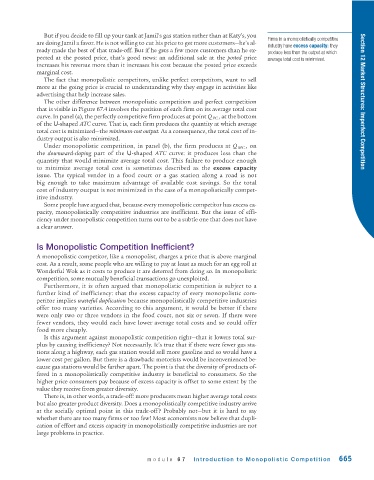Page 707 - Krugmans Economics for AP Text Book_Neat
P. 707
But if you decide to fill up your tank at Jamil’s gas station rather than at Katy’s, you
Firms in a monopolistically competitive
are doing Jamil a favor. He is not willing to cut his price to get more customers—he’s al-
industry have excess capacity: they
ready made the best of that trade-off. But if he gets a few more customers than he ex- produce less than the output at which
pected at the posted price, that’s good news: an additional sale at the posted price average total cost is minimized.
increases his revenue more than it increases his cost because the posted price exceeds
marginal cost.
The fact that monopolistic competitors, unlike perfect competitors, want to sell
more at the going price is crucial to understanding why they engage in activities like
advertising that help increase sales.
The other difference between monopolistic competition and perfect competition Section 12 Market Structures: Imperfect Competition
that is visible in Figure 67.4 involves the position of each firm on its average total cost
curve. In panel (a), the perfectly competitive firm produces at point Q PC , at the bottom
of the U-shaped ATC curve. That is, each firm produces the quantity at which average
total cost is minimized—the minimum-cost output. As a consequence, the total cost of in-
dustry output is also minimized.
Under monopolistic competition, in panel (b), the firm produces at Q MC , on
the downward-sloping part of the U-shaped ATC curve: it produces less than the
quantity that would minimize average total cost. This failure to produce enough
to minimize average total cost is sometimes described as the excess capacity
issue. The typical vendor in a food court or a gas station along a road is not
big enough to take maximum advantage of available cost savings. So the total
cost of industry output is not minimized in the case of a monopolistically compet-
itive industry.
Some people have argued that, because every monopolistic competitor has excess ca-
pacity, monopolistically competitive industries are inefficient. But the issue of effi-
ciency under monopolistic competition turns out to be a subtle one that does not have
a clear answer.
Is Monopolistic Competition Inefficient?
A monopolistic competitor, like a monopolist, charges a price that is above marginal
cost. As a result, some people who are willing to pay at least as much for an egg roll at
Wonderful Wok as it costs to produce it are deterred from doing so. In monopolistic
competition, some mutually beneficial transactions go unexploited.
Furthermore, it is often argued that monopolistic competition is subject to a
further kind of inefficiency: that the excess capacity of every monopolistic com-
petitor implies wasteful duplication because monopolistically competitive industries
offer too many varieties. According to this argument, it would be better if there
were only two or three vendors in the food court, not six or seven. If there were
fewer vendors, they would each have lower average total costs and so could offer
food more cheaply.
Is this argument against monopolistic competition right—that it lowers total sur-
plus by causing inefficiency? Not necessarily. It’s true that if there were fewer gas sta-
tions along a highway, each gas station would sell more gasoline and so would have a
lower cost per gallon. But there is a drawback: motorists would be inconvenienced be-
cause gas stations would be farther apart. The point is that the diversity of products of-
fered in a monopolistically competitive industry is beneficial to consumers. So the
higher price consumers pay because of excess capacity is offset to some extent by the
value they receive from greater diversity.
There is, in other words, a trade-off: more producers mean higher average total costs
but also greater product diversity. Does a monopolistically competitive industry arrive
at the socially optimal point in this trade-off? Probably not—but it is hard to say
whether there are too many firms or too few! Most economists now believe that dupli-
cation of effort and excess capacity in monopolistically competitive industries are not
large problems in practice.
module 67 Introduction to Monopolistic Competition 665

